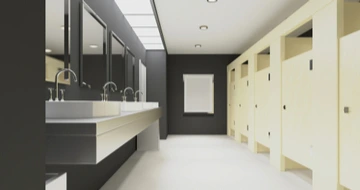Implementing Real-Time Analytics: A Q&A with Simon Carter
Smart buildings and accurate occupancy data are revolutionising the workplace. Businesses are using the information now at their disposal to understand how buildings are used to enhance the employee experience, improve space utilisation and reduce energy consumption.
But the inevitable change that follows needs to be carefully managed. As Head of Corporate Property at National Grid, Simon Carter implemented a pilot project and eventually a full rollout of True Occupancy, making significant changes to the organisation, while improving working lives and drastically reducing costs.
In addition to 14 years at National Grid, Simon has worked in real estate management and on business improvement projects in Japan, the US and the UK. He’s now working with True Occupancy through his own firm - Anticus Consulting - and we spoke to him about his experience of implementing a real-time occupancy analytics solution and where he sees the market going.
In your role at National Grid, what was the problem you were trying to solve with the True Occupancy service and technology, and what were your key aims?
The organisation didn’t have an accurate way of monitoring footfall and measuring facilities and space usage, meaning much of its real estate is being under-utilised and energy usage was higher than it should have been.
We knew changes needed to be made, but there were widespread misconceptions in terms of the changes that needed to be made. Ultimately, existing environments did not provide employees with the spaces they need to perform at their best, both individually and collaboratively.
People were saying the spaces they were working in were too full, that they were over-occupied. But we had some tough targets in place. We needed to save £8 million a year, and that meant finding a system that would give us everything we need to make informed decisions about the space we had.
To do that, we had to increase workplace density–that’s the number of people per square metre–by around 30%. So we clearly had a significant gap between our ambition and how most people felt in the organisation.
We’d done some very basic and simple analysis that suggested spaces weren’t being fully utilised. For example, people would complain that restaurant queues were too long. But when you look closely, you see we are creatures of habit. At 12 o’clock, everybody stops working, goes to the restaurant and there’s a 20-minute queue. But at 25 past, there’s nothing. So, why not delay it a little bit?
We introduced the True Occupancy technology to help us understand exactly where we were. We wanted to increase collaboration and improve working lives, but also reduce energy use as part of National Grid’s corporate social responsibility targets.
Why and how did you implement an initial pilot project with True Occupancy system?
National Grid is an engineering organisation, so we had to prove virtually everything that we did to make sure we could stay on track. We would be dealing with 10,000 people in about 20 locations, so the pilot enabled us to identify what worked and what didn’t and get some significant feedback.
When it came to implementation, communication was vital. The people-counting sensors raised concerns about privacy, so we worked proactively with True Occupancy, staff and trade unions to prove the cameras embedded in the devices were only there to check the accuracy and commission the devices.
The sensors themselves are a bit like a smoke detector, very innocuous. We could see body heat and and we could tell whether or not people were moving, so we could track the numbers within various zones. But nobody could be identified, and staff were happy because they’d been involved from the start.
The rest was what you would normally do as part of a change management process: creating the plan and measuring the impact. We measured just about everything we could measure.
What were the key things you learnt through the pilot?
Some interesting things came out of it. Senior people tend to get their own offices, but ironically, we proved they’re hardly ever in them. If you ask them they’ll say: “But I’m always here, I’m in the office until 6 o’clock, 7 o’clock at night.”
They may be in the building, but when you actually measure how many hours people spend in their offices you realise they’re probably one of the most under-utilised assets in the estate.
When you look at overall occupancy levels, you realise that four out of ten workstations are occupied. Two out of ten have some signs of life, so someone’s left a computer on the desk or a jacket on the chair or something. But actually, four out of ten workstations are empty.
That proved to us that there was an opportunity. It doesn’t confirm you can take 40% more, as it’s not a uniform line, but we thought 30% could well be achievable.
People’s perception of how a workplace is used is often very different to the reality. We had people saying we needed more large meeting rooms, for up to 20 people, but the analysis showed most people meet in twos, threes and fours, so really we needed more breakout space.
What were the key outcomes from the project at National Grid?
Well, we did achieve our annual savings of £8 million. We had a 16% reduction in energy use and pushed up asset utilisation by about 15%.
We also increased workplace capacity by 27%, so those are good, solid savings. But more than that, we also delighted our people. We used independent psychometric testing in the old and new workspaces and we had 8% increases in employee satisfaction and productivity.
People like being able to see when the gym is busy, what the busiest times in the restaurant queue are, and how office space is really used. The choices and the variety of spaces we introduced ultimately enabled people to perform better.
Another key outcome was the ability to clearly demonstrate compliance with fire risk assessments and insurance documentation. This can be difficult in a flexible working environment, but something like True Occupancy allows you to monitor exactly how many people are in a space.
What would be the key points of advice you would give to another company looking to implement a project with occupancy analytics to ensure success?
Try to understand how you might deploy a system like True Occupancy. It’s easy to get carried away with trying to monitor every seat, every workstation, but what you need is usually a zonal approach.
You want to make your changes really stick, so it’s also important to think about a mindset change. What are your business objectives? How do you want people to operate? Communication is really important so you need to put the effort into training days and workshops and definitely invest in someone to take on a change management role.
Finally, test everything. And I mean everything. I went in one day during our pilot and I couldn’t sit anywhere; the only place I could sit was on the floor. We tested it to destruction, but we tested it openly so everyone understood what works and what doesn’t.
What’s your view on where the market is going?
Like Internet of Things devices, I think occupancy sensors will be everywhere and quite soon. New buildings can easily adopt new systems and integrate them, although connecting systems, like BMS’s, will take longer because no standard exists.
Workplaces are becoming more flexible; you can come and go freely and permanent places for people are less common. Larger corporates in particular are pushing boundaries, bringing business and real estate change together and monitoring it.
Of course, it can be hard work to effect real change, but employees are becoming increasingly interested in their employers’ corporate social responsibility, energy usage and attitudes to climate change. Money usually comes first when convincing an organisation to change, but once the potential cost savings are clear, all the other employee benefits just seal the case for change and implementation.
A final word from us…
Rather than a one-off sink or swim initiative, occupancy analytics should be perceived as a bespoke, long-term work in progress, centred around a rigorous ambition to continually measure, adapt and optimise with the occupiers front of mind. Companies driving that change will unlock untapped potential for progress, both in terms of property and the people who occupy it.
Ready to get started with occupancy data analytics?
True Occupancy ‘Quick Start Kits’ are the perfect opportunity for you to test how our technology works, assess the data you get out of them and start to demonstrate ROI.
See occupancy through a different lens - click here to find out more.
Share this
You May Also Like
These Related Posts

4 Reasons Why Your Office Washroom Needs an Occupancy Sensor

Using workplace people counting to create an occupant-centric building

How Workplace Occupancy Sensors Improve Employees’ Experience
Connect with us
Need more information? Ready to get started? We're here to help, get in touch.


